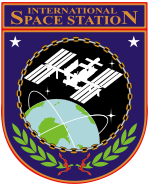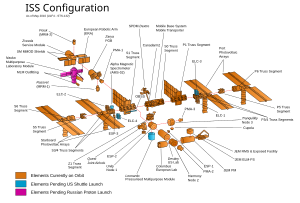Ibùdó Òfurufú Akáríayé
Ibùdó Òfurufú Akáríayé (International Space Station; ISS) je ile iwadi to je ti kariaye to n je sisopo ni oju-ona ayipo Aye nisale.
Won bere si ni ko si oju-ona ayipo ni 1998 eto sini pe yio pari ni opin 2011. Ireti ni pe ibudo oko na yio sise titi di odun 2015, o si se e se ko di 2020. Nitoripe ipo re ju ibudo ofurufu yiowu tele lo, ISS se ri lati Aye pelue oju korokoro, be si, títí di 2010[update], ohun ni ateleyin oniseowo titobijulo to n yipo Aye.
 | ||
| The International Space Station on 17 April 2010 as seen from the departing Ọkọ̀-àlọbọ̀ Òfurufú Discovery during STS-131. | ||
 | ||
| ISS Insignia | ||
| Station statistics | ||
|---|---|---|
| NSSDC ID: | 1998-067A | |
| Call sign: | Alpha | |
| Crew: | 6 | |
| Launch: | 1998–2011 | |
| Launch pad: | KSC LC-39, Baikonur LC-1/5 & LC-81/23 | |
| Mass: | 344,378 kg (759,224 lb) | |
| Length: | 73 m (240 ft) from PMA-2 to Zvezda | |
| Width: | 108.5 m (356 ft) along truss, arrays extended | |
| Height: | c. 20 m (c. 66 ft) nadir–zenith, arrays forward–aft | |
| Living volume: | c. 835 m3 (c. 29,500 cu ft) (18 May 2010) | |
| Atmospheric pressure: | 101.3 kPa (29.91 inHg) (1 atm) | |
| Perigee: | 336 km altitude (181 nmi) | |
| Apogee: | 346 km altitude (189 nmi) | |
| Orbit inclination: | 51.6419 degrees | |
| Average speed: | 7,706.6 m/s (27,743.8 km/h, 17,239.2 mph) | |
| Orbital period: | c. 91 minutes | |
| Days in orbit: | 9291 (Àdàkọ:Date) | |
| Days occupied: | 8580 (Àdàkọ:Date) | |
| Number of orbits: | c. 146632 (Àdàkọ:Date) | |
| Orbital decay: | 2 km/month | |
| Statistics as of 27 November 2009Àdàkọ:Update after (unless noted otherwise) | ||
| References: | ||
| Configuration | ||
 | ||
| Station elements títí di 18 Oṣù Kàrún 2010[update] (exploded view) | ||
 | Àyọkà yìí tàbí apá rẹ̀ únfẹ́ àtúnṣe sí. Ẹ le fẹ̀ jù báyìí lọ tàbí kí ẹ ṣàtúnṣe rẹ̀ lọ́nà tí yíò mu kúnrẹ́rẹ́. Ẹ ran Wikipedia lọ́wọ́ láti fẹ̀ẹ́ jù báyìí lọ. |
Itokasi
Àdàkọ:ISS modules Àdàkọ:International Space Station Àdàkọ:Manned ISS flight Àdàkọ:Space stations Àdàkọ:US manned space programs Àdàkọ:Russian manned space programs
This article uses material from the Wikipedia Yorùbá article Ibùdó Òfurufú Akáríayé, which is released under the Creative Commons Attribution-ShareAlike 3.0 license ("CC BY-SA 3.0"); additional terms may apply (view authors). Gbogbo ohun inú ibí yìí wà lábẹ́ CC BY-SA 4.0 àyàfi tí a bá sọ pé kò rí bẹ̀ẹ̀. Images, videos and audio are available under their respective licenses.
®Wikipedia is a registered trademark of the Wiki Foundation, Inc. Wiki Yorùbá (DUHOCTRUNGQUOC.VN) is an independent company and has no affiliation with Wiki Foundation.